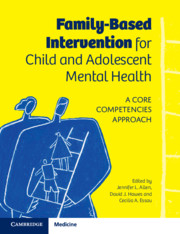Book contents
- Family-Based Intervention for Child and Adolescent Mental Health
- Family-Based Intervention for Child and Adolescent Mental Health
- Copyright page
- Contents
- Contributors
- Preface
- Part I Theoretical Perspectives on Family-Based Intervention
- Chapter 1 A Core-Competency Perspective on Family-Based Intervention for Child and Adolescent Mental Health
- Chapter 2 The Role of the Family in Child and Adolescent Psychopathology
- Chapter 3 Implementation of Family-Based Intervention
- Chapter 4 Effective Components of Parenting Programmes for Children’s Conduct Problems
- Part II Core Clinical Competencies
- Part III Family Intervention for Specific Child and Adolescent Mental Health Problems
- Part IV Family Intervention for Children at Risk Due to Family Dysfunction or Past Adversity
- Part V New Developments in Family-Based Intervention
- Index
- References
Chapter 2 - The Role of the Family in Child and Adolescent Psychopathology
from Part I - Theoretical Perspectives on Family-Based Intervention
Published online by Cambridge University Press: 18 February 2021
- Family-Based Intervention for Child and Adolescent Mental Health
- Family-Based Intervention for Child and Adolescent Mental Health
- Copyright page
- Contents
- Contributors
- Preface
- Part I Theoretical Perspectives on Family-Based Intervention
- Chapter 1 A Core-Competency Perspective on Family-Based Intervention for Child and Adolescent Mental Health
- Chapter 2 The Role of the Family in Child and Adolescent Psychopathology
- Chapter 3 Implementation of Family-Based Intervention
- Chapter 4 Effective Components of Parenting Programmes for Children’s Conduct Problems
- Part II Core Clinical Competencies
- Part III Family Intervention for Specific Child and Adolescent Mental Health Problems
- Part IV Family Intervention for Children at Risk Due to Family Dysfunction or Past Adversity
- Part V New Developments in Family-Based Intervention
- Index
- References
Summary
Child and adolescent mental health is understood to be highly embedded in the family system, particularly the parent-child relationship. Indeed, models of risk pathways to psychopathology emphasize interactions and transactions between the family environment and individual differences at the child level, including gene-environment interplay. Therapist knowledge regarding the role of the family in these pathways is central to the clinical competencies involved in the evidence-based treatment of children and adolescents. This chapter provides an overview of current theory regarding family contributions to the major forms psychopathology seen among children and adolescents. Attention is given to key family and parenting variables as they are conceptualized in the current literature, the mechanisms by which these variables contribute to the emergence and maintenance of psychopathology and the origins and determinants of parenting.
- Type
- Chapter
- Information
- Family-Based Intervention for Child and Adolescent Mental HealthA Core Competencies Approach, pp. 14 - 28Publisher: Cambridge University PressPrint publication year: 2021
References
- 2
- Cited by

